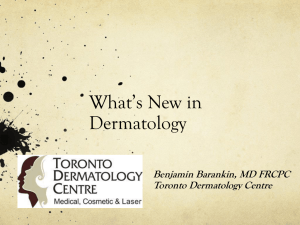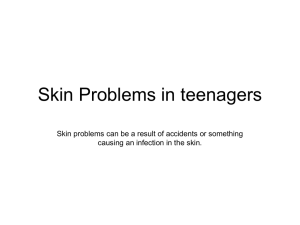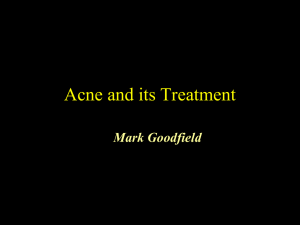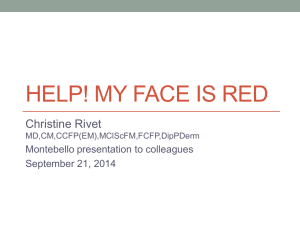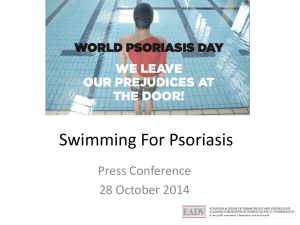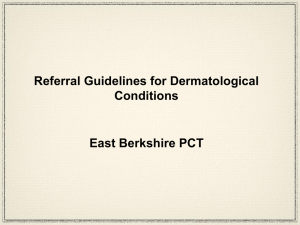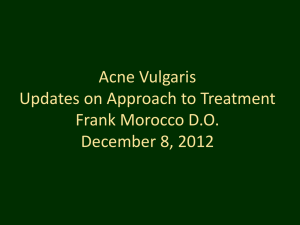Psoriasis
advertisement
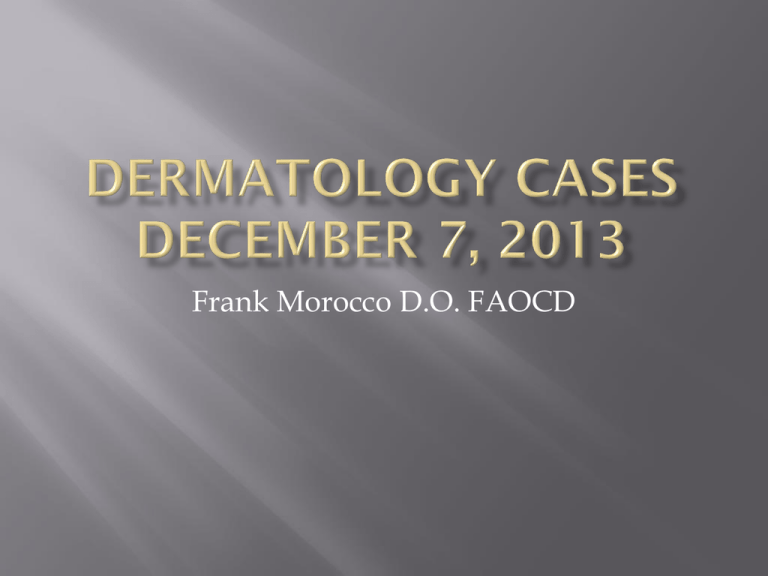
Frank Morocco D.O. FAOCD Case 1 51 y/o white male with 4 year history of silvery scaling thickened erythematous plaques on his knees, elbows and scalp. The patient has 25% BSA. Denies any joint pain. • • • • A) Involves only the skin and should be managed exclusively by a dermatologist B) Is associated with multiple comorbidities including diabetes, hyperlipidemia, and arthritis C) Statins have been shown to worsen psoriasis D) Topical therapy should be continued as monotherapy for multiple years before switching to a different treatment modality Psoriasis is a hereditary, papulosquamous skin disorder that affects 3 to5 million people in the United States. Affects men and women equally. Psoriasis is a chronic and recurring disease that is best characterized by well-demarcated erythematous plaques Most commonly plaques are seen on the elbows, knees, and the scalp • Psoriasis is an immune mediated inflammatory skin disorder. – • • • TH1 driven with increase of IL-6, TNF-alpha and Interferon Unpredictable Age of onset bimodal 23 y/o and 55 y/o Aggravated by emotional stress In addition to its cutaneous manifestations, psoriasis has been associated with arthritis Psoriatic Arthritis Psoriatic arthritis affects an estimated 25% to 34% of patients with psoriasis Most commonly appears 10 years after the onset of psoriasis •Psoriatic Arthritis: 5 patterns 1. Asymmetric DIP with nail damage (16%) 2. Arthritis mutilans with osteolysis of phalanges/metacarpal s (5%) 3. Symmetric polyarthritis-like RA with claw hands (15%) 4. Oligoarthritis with swelling and tenosynovitis of one or a few hand joints (70%) 5. Ankylosing spondylitis alone or with peripheral arthritis (5%) Psoriatic Arthritis (cont’d) X-rays resemble RA except: Erosion of terminal phalangeal tuft Tapering or whittling of phalanges or metacarpals Cupping of proximal phalanges Bony ankylosis Osteolysis of metatarsals Prediliction for DIP and PIP Sparing of MCP and MTP Paravertebral ossification Asymmetric sacroilitis; rarity of bamboo spine Quality of life A population-based survey looking at the association between quality of life and extent of disease. 60% of patients report psoriasis affects their everyday life and 26% report a change or discontinuation of daily activities. This was higher than cancer and diabetes!! • Economic – The estimated total direct and indirect health care cost of psoriasis in the United States is 11.25 billion dollars annually – A two-year study by the National Psoriasis Foundation (NPF) found that having psoriasis is associated with decreased household incomes and reduced employment opportunities. – Psoriasis patients have lower income and are less likely to work full-time. – Psoriasis was reported as the primary reason for unemployment in 17% of patients with severe psoriasis. – Psoriasis patients missed an average of 26 days of work each year due to complications of psoriasis • • • • Psoriasis may predispose patients to increased risk of atherosclerotic disease. A chronic, proinflammatory state that fosters the development of the metabolic syndrome. 40 % of psoriatic patients develop metabolic syndrome Chronic inflammation to increased oxidative modifications of lipoproteins, which are more atherogenic than native lipoproteins Diabetes The studies suggest that psoriasis is associated with a 59% increased prevalence of diabetes and a 27% increased risk of developing diabetes among patients with psoriasis The altered immune pathways may also predispose to impaired glucose tolerance and diabetes Aggressive therapy ? Hyperlipidemia 19 of 19 studies showed an association with hyperlipidemia Study subjects had higher levels of very low density lipoproteins,total cholesterol and LDL,and lower levels of cardioprotective high density lipoproteins (HDL) 63 pts 32 pts on Atorvastatin 20mg/day 31 pts on placebo 80% reached PASI 75 in 6 months 78% reach PASI 75 in 3 months with ustekinumab Also showed significant reduction of CRP and TNF alpha after 3 weeks Topicals or localized tx (laser/pulsed light) for limited plaques Phototherapy MTX Cyclosporin Biologics Rotating therapies and combination therapies • Corticosteroids: Class I for 2 weeks, then weekend pulses Occlusion for thick keratotic scale – Low-mid strength intertriginous and face – Can give ILK for refractory plaques and nail matrix and lateral nailfold monthly – • • Tazarotene: modulates keratinocyte differentiation and hyperproliferation and suppresses inflammation Calcipotriene: keratinocyte differentiation Burning can cause Koebner’s phenomenon Artificial UVB broad or narrow band 254, 280, 290 are ineffective 296, 300, 304, 313 give clearing Narrow band = 311 and is more effective than broad band • • • Psoriasis is associated with comorbid conditions, including depression, arthritis, diabetes, hypertension, metabolic syndrome, and cardiovascular events A systemic inflammatory processes may underlie these disease processes. Treatment must involve a multidisciplinary approach between Dermatologists, PCP cardiologists and rheumatologists Case # 2 -Patient S.S. is a 16 month old boy brought in to see you by his parents for an itchy rash. -“rashy skin” intermittently since birth. -worst during the winter months of the year. -Mom reports that he scratches in his sleep. The parents tell you that S.S. was hospitalized at age 6 months for reactive airway disease for which he required nebulizers. -His mom has strong allergies to pollens in the summer. -Dad has asthma. -S.S. uses Suave Berry Blast soap and shampoo in the bathtub. He takes one bath every other day. They have tried Vaseline intensive care lotion when his skin seems dry. The Itch that Rashes Eptheilial barrier disruption 50% of atopic dermatitis caused by Filaggrin gene (FLG) disorder FLG encodes profilaggrin which is the major component of granular layer. Filaggrin makes up the the major scaffolding that forms the lipid cell envelope. Filaggrin is degraded and forms “natural moisturizing factor” Decreases pH which helps inhibit Staphylococcus aureus growth Activate enzymes in ceramide metabolism Modulating the activity of serine proteases Epidermal barrier repair is aimed at replacing ceramides, inhibition of elevated protease activity and decreasing skin pH In vitro studies have shown immunity still has major effect. IL-22 and IL-25 are involved in decreasing filaggrin expression. Decrease of active copies of fillagran by 5-10% can increase severity of atopic dermatitis. Other Factors Delayed introduction of solid foods, early life exposure to antibiotics, exposure to farm animals or ingestion of fish oils have no effect on development of AD Breast-feeding has been shown to have no effect Physiologic and psychological benefits of breast feeding makes it preferred feeding modality even in children with risk of developing AD • Children < 5 y/o with moderate to severe AD should be considered for food allegies to milk, egg, peanut wheat, and soy IF persistant atopic dermatitis with optimal treatment or if there is a history of immediate reaction after the ingestion of a specific food Fifty percent to 90% of presumed allergies are not allergic in nature Solid foods should not be delayed beyond 4 to 6 months, because this may paradoxically increase the incidence of food allergies Individuals without documented or proven food allergies should not avoid potential allergenic foods Proposed Mechanisms Negative effect of inflammatory cytokines on central nervous system Increased stress and sleep disturbances due to pruritis. Lack of impulse control and use of stimulatory medication makes ADHD a risk factor for more severe AD • • • Dennie-Morgan fold: linear transverse fold just below the lower eyelid “Normal” skin is subclinically inflamed, dry, scaly Pityriasis alba: – • hypopigmentation with sclight scale on cheeks, upper arms, trunk in young children. Responsive to emollients and topical steroids Keratosis pilaris: – horny follicular lesions of outer aspects of upper arms, legs, cheeks, and buttocks; refractory to treatment Increased susceptibility of infection; Patients heavily colonized with Staph. Treatment of lesional skin reduces colonization even w/o ABX Eczema herpeticum: generalized herpes simplex, sudden vesicular, pustular, crusted or eroded lesions. Become secondarily infected. Eczema vaccinatum: widespread vaccinia infxn Extensive flat wart or molluscum; poor tolerance to Tx Infants and children: Avoid hot baths, alkaline soaps, vigorous rubbing and scrubbing. Short, once-a-day, tepid baths followed by a barrier cream using soak and smear; ointment bases are preferred. Immediate change of wet or soiled diapers. Nighttime sedating antihistamines for itch Dietary restriction for a specific known antigen Adults Avoid temperature extremes Hydrate dry skin especially in winter Avoid overbathing and hot water Avoid wool Biofeedback techniques for emotional stress Topical corticosteroids are the mainstay 1-2.5% hydrocortisone in infants. Monitor growth in infants and young children. Mid-potency (TAC) in older children and adults except on the face 1-2x a day is enough to saturate receptors; more provides only emollient effect Occlusion increases penetration and receptor saturation Must be strong enough to control pruritus and remove inflammation Regular emollients: petrolatum, hydrophilic creams with ceremides Anti-Staph therapy for acute flares Topical calcineurin inhibitors Antihistamines for sedation: hydroxyzine, diphenhydramine, or clopheniramine. The nonsedating antihistamines do not relieve pruritus Short courses of anti-Staph ABX, topical mupirocin for nasal carriage Immunosuppressives and antiproliferatives (Immuran, Cellcept, MTX) can be effective for unresponsive dz Phototherapy: PUVA, UVA, narrow-band UVB, or Goeckerman with tar may be helpful Increased risk of S. Aureus infection and colonization which leads to inflammation ◦ Decreased Human Beta-defensin-2 leads to increased MSSA. A recent study showed that diluted bleach baths plus intranasal mupirocin led to significant improvement in eczema severity scores. ◦ Typical recipe is ¼ cup of bleach for ½ tub of water and ½ cup of bleach for tub full of water ◦ Mupirocin was administered 5 consecutive days a month Wet dressing therapy was has been used in past for severe AD. Recent study from Mayo Clinic described their institution’s wet dressing therapy for inpatient hospitalizations. 45% had 75%-100% clearance 38% had 50%-75% clearance Traditional AD management dogma consisted of application of anti-inflammatory medication to areas of “active”disease. Recent research shows a paradigm shift. After twice daily active treatment of AD flare, patients were given “proactive” twice weekly treatment with topical tacrolimus and had significant fewer AD flares An 18-year-old patient presents with a sore throat and signs of streptococcal pharyngitis. you start treatment with amoxicillinclavulanate, and results of a rapid strep test are positive. The next day the patient calls regarding a new rash that has erupted all over his body. The palms and soles remain uninvolved a. Drug rash b. Pityriasis rosea c. Streptococcal scalded skin syndrome d. Mycoplasma pneumonia e. Psoriasis • • • • • Guttate psoriasis classically presents after infection with streptococcus in children or young adults. Guttate psoriasis presents with scaly, “droplike” papules on the trunk and extremities. It is often mistaken for a drug rash because antibiotics may have been initiated for the streptococcal infection. Throat cultures for streptococcal pharyngitis should be obtained. Guttate psoriasis has a good prognosis and may disappear spontaneously or may benefit from phototherapy. A 28-year-old man presents with a rash and pruritus that has been present for 3 weeks. He has no history of skin or other health problems and is not receiving any medications. He has used no new products on the skin and has not frequented wooded areas. On examination, he has red papules and excoriations on the wrists, groin, and axillae and nodular areas on his scrotum A) Mineral oil preparation of a skin scraping B). Tissue transglutaminase measurement C). Skin biopsy D). Lyme disease serology E). Skin biopsy for tissue culture Scabies is caused by infestation of the epidermis with the mite. Infestation occurs as a result of direct skin-to-skin contact; fomite transmission is uncommon. Scabies causes epidemics in schools, nursing homes, and hospitals. Pruritus is the major complaint, prominently at night, and there is often a history of itching or rash in family members The rash is due to hypersensitivity reaction to the mite protein. It can take 4 to 6 weeks after initial mite exposure to develop signs or symptoms of scabies infestation Clinical features include inflammatory, excoriated papules in the web spaces of the hands and feet, the axillae, groin, wrists, and areolae, and submammary sites in women. Facial or scalp involvement is uncommon, except in children and elderly persons. Nodules or thickened areas in the scrotum are also a helpful clue Scabies The pathognomonic finding is a burrow, commonly located on the hands. Identification of mites, eggs, or fecal material on a scabies preparation is diagnostic. Treatment of classic scabies includes the topical application of permethrin, and/or oral ivermectin Permethrin is the gold standard therapy Ivermectin is an effective oral alternative that is especially useful in crusted scabies, patients who are bedridden, and in institutional outbreaks. Treatment failures still occur, mostly secondary to application error (ie, failure to treat the face and scalp or close contacts, failure to reapply medication) or failure to decontaminate fomites. • • • There has been a recent shift in standard of care for scabies treatment. Routine treatment of the scalp and face and retreating patients between day 4 and 7 based on the scabies life cycle to ensure more efficient mite eradication. Practitioners should attempt to treat all close contacts simultaneously with the source patient. 300 volunteers who lay nude in warm beds recently vacated by scabetic hosts infected with <20 mites, 4 (1.3%) became infested. The number rose to 15% when hosts had >50 mites May live on fomites 24-36 hrs in warm humid environment May live on fomites 19 DAYS in cool environment!!! To eradicate mites, all fomites should be placed in a dryer for 10 minutes on a high setting, furniture and carpets vacuumed, and nonlaunderables isolated for a minimum of 2 days • • An 18-year-old man originally presented to your urgent care clinic 4 weeks ago with a small abscess on his knee. He was otherwise healthy and taking no medications. The abscess was incised and drained at the clinic, and the culture and susceptibility studies showed this lesion to be a methicillin-resistant Staphylococcus aureus infection. He now presents with a new abscess. On physical examination, his temperature is 37°C, blood pressure is 118/76 mm Hg, and heart rate is 80 beats/min. Skin examination shows a 2x2-cm erythematous plaque on the forearm with a central fluctuant area. There are areas of healing skin on the knee. A). Education on wound care and personal hygiene B). Oral rifampin C). Intravenous vancomycin D). Oral clindamycin E). Combination treatment with oral trimethoprim-sulfamethoxazole and minocycline This patient presents with the typical history and physical findings of a skin and soft tissue infection (SSTI) with community-associated methicillin-resistant S aureus (CAMRSA). Infections caused by CA-MRSA usually present as a solitary abscess, cellulitis, or soft tissue infection, often with central necrosis. Recurrence in an individual is common This strain of MRSA has a distinct genetic resistance element (SCCmec IV) and toxin (Panton-Valentine leukocidin toxin) and develops in populations with close physical contact. While resistant to beta-lactam antibiotics, CA-MRSA isolates often remain sensitive to other antibiotics such as clindamycin,trimethoprim-sulfamethoxazole, and minocycline • • • • • The primary treatment for a small, simple cutaneous abscess is incision and drainage of the abscess. Management of recurrent MRSA infections should focus on education about appropriate wound care and personal hygiene. Instruction should include keeping draining wounds covered with clean, dry bandages, maintaining good personal hygiene with regular bathing , cleaning of hands, and avoiding reusing or sharing personal items. Clinicians should consider attempting decolonization if a patient experiences a recurrent SSTI despite optimal wound care and hygiene measures. Decolonization strategies may include nasal decolonization with mupirocin twice a day for 5 to 10 days and body decolonization with a skin antiseptic solution (chlorhexidine) for 5 to 14 Days or dilute bleach baths.` Infantile hemangiomas are the most common tumor of infancy and arise in 5% to 10% of infants Glucose 1 transporter (GLUT-1) has be shown to be specific for infantile hemangiomas • The expected proliferation phase of hemangiomas is during the first year of life with rapid growth until 6-9 months of age. – – – A recent found most rapid growth between age 5.5 7.5 weeks Best age for referral 4 weeks old Hemangioma precursors were present at birth in 65% of patients Early white discoloration heralds impending ulceration Usually seen before 3months of age In contrast to the whitish gray color of involution seen several moths later One of the greatest breakthroughs in pediatric dermatology has revolved around IH and propranolol. Mechanism of action is unknown Vasocostriction Blocking proangiogenic signals Apoptosis of endothelial cells 2008- The discovery was made after 2 children with cardiac issues were treated with oral beta blockers with great effectiveness 2009- 32 children treated with oral propranolol all had good response 2011 – 40 pts given 2 mg/kg per day divided 3 times daily for 6 months. Baseline electrocardiogram, echocardiogram, and laboratory evaluations were performed. Monitoring of heart rate, blood pressure, and blood glucose was performed at each visit. No significant hypoglycemia, hypotension, or bradycardia occurred. Growth stopped at 4 weeks 2011- Propranolol vs corticosteroids multicenter retrospective analysis 139 patients 82% achieved clearance of 75% or more on propranolol compared to 29% who were receiving oral corticosteroids This study helped show superior efficacy with fewer side effects. Infantile Hemangiomas that ulcerate are prone to considerable morbidity with pain, infection, and scarring Challenging to treat When compared to traditional modalities for treatment (PDL, wound care, oral antibiotics and oral corticosteroids) propranolol was found to shorten time to healing after the onset of ulceration Average time to heal from onset of ulceration with propranolol 8.7 weeks compared to 22.4 weeks with wound care Head and neck hemangiomas 4.3 weeks to heal and 14.5 days to achieve pain control Propranolol is now considered standard of care for severe IH but it is being used more in less aggressive IH. Most patients are started on a low dose and titrated up to 2 mg/kg/day in divided doses Rare side effects include hypoglycemia, hypotension, and exacerbation of asthma More common side effects are cold extremities and night terrors Other systemic beta blocker are being examined. Atenolol is a hydrophilic beta-1 antagonist that may decrease pulmonary side effects and sleep disturbances. Nadolol has been compared to propranolol in a small case study which showed superior efficacy decreased side effects and easier dosing schedules due to a longer half life. Topical beta-blocker in the form of timolol has been tried with success for superficial small hemangiomas not requiring systemic treatment Tinea capitis occurs mainly in children, although it may be seen at all ages. Boys have tinea capitis more frequently than girls Tinea Capitis is more prominent in African Americans Tinea capitis must be differentiated clinically from chronic staphylococcal folliculitis, psoriasis, seborrheic dermatitis, various inflammatory follicular conditions. The distinctive clinical features of tinea capitis are broken-off stumps of hairs, often in rounded patches in which there are crusts or pustules and few hairs. The broken-off hairs are loose and when examined are found to be surrounded by, or to contain, the fungus. Diffuse seborrheic scaling with hair loss is a common presentation of T. tonsurans infections. In seborrheic dermatitis the involved areas are covered by fine, dry, or greasy scales. Hair may be lost, but the hairs are not broken. Atopic dermatitis is rarely associated with localized scalp involvement, and clinical examination frequently reveals more typical generalized findings. In psoriasis, well-demarcated, sometimes diffuse, areas of erythema and white or silver scaling are noted. Lichen simplex chronicus is frequently localized to the inferior margin of the occipital scalp. Numerous clinical trials exist that demonstrate the effectiveness of itraconazole, terbinafine, and fluconazole. Despite these studies, griseofulvin remains the most commonly used antifungal agent in children. A meta-analysis of published studies shows mean efficacy for griseofulvin treatment of about 68% for Trichophyton spp For the ultramicronized form, doses start at 10 mg/kg/day. The tablets can be crushed and given with ice cream. Grifulvin V oral suspension is less readily absorbed. The dose is 20 mg/kg/day. Treatment should continue for 2–4 months, or for at least 2 weeks after negative laboratory examinations are obtained. Doses much higher than those reflected in drug labeling are commonly needed. For Trichophyton infections, terbinafine is commonly effective in doses of 3–6 mg/kg/day for 1–4 weeks. Alternate dosing schedules for terbinafine include one 250 mg tablet for patients over 40 kg, 125 mg (half of a 250 mg tablet) for those 20–40 kg, and 62.5 mg (onequarter of a 250 mg tablet) for those under 20 kg. Selenium sulfide shampoo or ketoconazole shampoo left on the scalp for 5 min three times a week can be used as adjunctive therapy to oral antifungal agents to reduce the shedding of fungal spores. Combs, brushes, and hats should be cleaned carefully and natural bristle brushes Mild inflammatory exanthem: salmoncolored oval/circinate papules/macules with collarette scale Hanging curtain sign: scales fold across lines of stretched skin Long axis parallels lines of cleavage Herald patch Age 15-40 in spring and autumn May have mild pruritus Spontaneous resolution after 3-8 weeks Inverse and papular variants Etiology: may be associated with HHV-6 and 7 reactivation A similar eruption may occur as reaction to drugs Histology: mild acanthosis, focal parakeratosis, erythrocyte extravasion, spongiosis, mild dermal perivascular infiltrate DDX: seb derm, tinea corporis, macular syphilid, drug eruption, viral exanthem, PSO Treatment: most require none UVB may expedite the involution Corticosteroid lotions or creams, oral antihistamines, erythromycin emollients 15-year-old male Non-inflammatory & inflammatory papules Face only Open/closed comedones Papules Diagnosis ? Treatment Plan? Noninflammatory Acne Mild Inflammatory Acne Topical Therapies Retinoids Antibiotics Salacylic Acid BPO +/- Washes Adjunctive Therapies OCPs, chemical peels, anti-androgens Moderate-Severe Inflammatory Acne Oral antibiotics Severe or Scarring Adjunctive Therapies Isotretinoin Tetracyclines Failure of oral antibiotics Pregnant Azelaic Acid (Cat B) Clindamycin Lotion (Cat B) Early, appropriate treatment is best to minimize potential for acne scars Approach should be multi-therapy, not monotherapy Combination of a topical retinoid and antimicrobial agent remains the preferred approach for almost all patients with acne . Thiboutot D, et al. New insights into the management of acne: An update from the Global Alliance to Improve Outcomes in Acne Group J Am Acad Dermatol 2009;60:S1-50. Topical retinoids should be first-line agents in acne maintenance therapy Avoid contributing to antibiotic resistance . Thiboutot D, et al. New insights into the management of acne: An update from the Global Alliance to Improve Outcomes in Acne Group J Am Acad Dermatol 2009;60:S1-50. • Mechanism of action1 – – – • Bactericidal for P. acnes Inhibits triglyceride hydrolysis Decreases inflammation of acne lesions Advantages No resistance demonstrated to date1 When used in combination with a topical antibiotic can help to prevent resistance2 – Activity is enhanced when combined with other topicals (i.e. clindamycin)1,2 – – • Formulations – – OTC & prescription Washes, gels, lotion, solution 1. Wolverton SE. editor Comprehensive Dermatologic Drug Therapy 2nd Ed. Philadelphia: Saunders Elsevier; 2007. 2. Thiboutot D, et al. New insights into the management of acne: An update from the Global Alliance to Improve Outcomes in Acne Group. J Am Acad Dermatol 2009;60:S1-50. • • • Most important class of drugs used to treat acne Topical form of vitamin A Mechanism of Action1 – – • Normalize follicular keratinization Act on the microcomedone Proper instruction on application is essential to compliance – – Gradual application with small amount of drug “Training for a marathon” 1. Wolverton SE. editor Comprehensive Dermatologic Drug Therapy 2nd Ed. Philadelphia: Saunders Elsevier; 2007. • “Least Irritating” (most tolerable) – – • Adapalene gel (Differin® 0.1%, 0.3%) May be appropriate starting point for ethnic and/or sensitive skin “Moderately Irritating” – Tretinoin (cream, gel) • • • • • Tretinoin 0.01%, 0.05%, 0.025% Retin-A Micro® 0.1%, 0.04% Atralin™ Gel 0.05% Renova® 0.02%, 0.05% “Most Irritating” (least tolerable) – Tazarotene (Tazorac®/Avage® 0.05%, 0.01%) Wolverton SE. editor Comprehensive Dermatologic Drug Therapy 2nd Ed. Philadelphia: Saunders Elsevier; 2007. • Erythromycin – – – • Clindamycin phosphate 1% – – – – • Akne-mycin® 2% gel, Erygel ® 2% gel, Resistance of some P. acnes strains Usage fallen out of favor Generic, Cleocin T® (lotion, gel, solution), Evoclin® foam Antibiotic-associated colitis very unlikely Work best in combination with BPO Good choice for pregnant women (Pregnancy Category B) Azelaic acid – – – Finacea™ Bacteristatic/bactericidal against P. acnes Good choice for pregnant women (Pregnancy Category B) Wolverton SE. editor Comprehensive Dermatologic Drug Therapy 2nd Ed. Philadelphia: Saunders Elsevier; 2007. • Clindamycin/Benzoyl peroxide – – – • Erythromycin/Benzoyl peroxide – • Erythromycin 3%/benzoyl peroxide 5% (Benzamycin®) Retinoid/Benzoyl peroxide – • Clindamycin phosphate 1%/benzoyl peroxide 5% (Benzaclin®Gel) Clindamycin phosphate 1%/benzoyl peroxide 5% (Duac®Gel) Clindamycin phosphate 1.2% /benzoyl peroxide 2.5% (Acanya™ Gel) Adapalene 0.1%/benzoyl peroxide 2.5% (Epiduo™ Gel) Retinoid/Clindamycin – Tretinoin 0.025%/Clindamycin phosphate 1.2% (Ziana® Gel) Thiboutot D, et al. New insights into the management of acne: An update from the Global Alliance to Improve Outcomes in Acne Group. J Am Acad Dermatol 2009;60:S1-50. • • 17-year-old-female Inflammatory acne Regular menstrual cycles (-flares) – Face, chest, back involved – Pustules, papules – Open & closed comedones – • Treatment plan? Noninflammatory Acne Mild Inflammatory Acne Topical Therapies Retinoids Antibiotics Salacylic Acid BPO +/- Washes Adjunctive Therapies OCPs, chemical peels, anti-androgens Moderate-Severe Inflammatory Acne Oral antibiotics Severe or Scarring Adjunctive Therapies Isotretinoin Tetracyclines Failure of oral antibiotics Pregnant Azelaic Acid (Cat B) Clindamycin Lotion (Cat B) Therapeutic role in acne Reduction of P. acnes Anti-inflammatory activity Dosing Start high then taper down after control is achieved Use PRN during flares Do not use as monotherapy Wolverton SE. editor Comprehensive Dermatologic Drug Therapy 2nd Ed. Philadelphia: Saunders Elsevier; 2007. • Antibiotic Choice – Tetracylcine Class (minocycline, doxycycline, tetracycline) • Solodyn® (minocycline HCl), Minocin ® (minocycline) • Doryx® (doxycycline hyclate), Adoxa® (doxycycline monohydrate) Erythromycin (Ery-tab®) – Trimethoprim/sulfamethoxazole – Amoxicillin – • Anti-inflammatory antibiotics/no antimicrobial activity Doxycycline 20 mg (Periostat®) – Doxycycline 40 mg (Oracea®) – Wolverton SE. editor Comprehensive Dermatologic Drug Therapy 2nd Ed. Philadelphia: Saunders Elsevier; 2007. • • • • Combine a topical retinoid plus an antimicrobial Limit the use of antibiotics to short periods and discontinue when there is no further improvement or the improvement is only slight Co-prescribe a BPO-containing product or use as washout Oral and topical antibiotics should not be used as monotherapy Thiboutot D, et al. New insights into the management of acne: An update from the Global Alliance to Improve Outcomes in Acne Group. J Am Acad Dermatol 2009;60:S1-50. • • 19-year-old female moderate to severe inflammatory acne – Regular menstrual cycles (+ flares) – – – – – • Face involved scarring Chest, back spared Nodular lesions along jawline Comedones Scarring Treatment plan? Noninflammatory Acne Mild Inflammatory Acne Topical Therapies Retinoids Antibiotics Salacylic Acid BPO +/- Washes Adjunctive Therapies OCPs, chemical peels, anti-androgens Moderate-Severe Inflammatory Acne Oral antibiotics Severe or Scarring Adjunctive Therapies Isotretinoin Tetracyclines Failure of oral antibiotics Pregnant Azelaic Acid (Cat B) Clindamycin Lotion (Cat B) Approved for the treatment of severe recalcitrant nodular acne in 1982 Member of the Vitamin A family Effects on acne Normalizes the keratinization process Reduces sebocytes and secretions Reduces inflammation Reduction in numbers of P. acnes Wolverton SE. editor Comprehensive Dermatologic Drug Therapy 2nd Ed. Philadelphia: Saunders Elsevier; 2007. Pre-medication counseling Side Effects Contraception Compliance/duration of treatment Laboratory monitoring iPledge registration Dosing 1-2 mg/kg/day Goal 120-150 mg/kg over course of treatment Wolverton SE. editor Comprehensive Dermatologic Drug Therapy 2nd Ed. Philadelphia: Saunders Elsevier; 2007. 1) Brown SJ, McLean WH. One remarkable molecule: filaggrin. J Invest Dermatol 2012;132:751-62. 2) Irvine AD, McLean WH, Leung DY. Filaggrin mutationsassociated with skin and allergic diseases. N Engl J Med 2011;365:1315-27. 3)Cork MJ, Danby SG, Vasilopoulos Y, Hadgraft J, Lane ME, Moustafa M, et al. Epidermal barrier dysfunction in atopic dermatitis. J Invest Dermatol 2009;129:1892-908 4) Roduit C, Frei R, Loss G, Buchele G, Weber J, Depner M, et al. Development of atopic dermatitis according to age of onset and association with early-life exposures. J Allergy Clin Immunol 2012;130:130-136.e5. 5) Kopp MV, Hennemuth I, Heinzmann A, Urbanek R. Randomized, doubleblind, placebo-controlled trial of probiotics for primary prevention: no clinical effects of lactobacillus GG supplementation. Pediatrics 2008;121:e850-6. 6) Ghali FE. ‘‘Car seat dermatitis’’: a newly described form of contact dermatitis. Pediatr Dermatol 2011;28:321-6. 7) Powell D, Ahmed S. Soccer shin guard reactions: allergic and irritant reactions. Dermatitis 2010;21:162-6. 8) Corella F, Garcia-Navarro X, Ribe A, Alomar A, Baselga E. Abortive or minimal-growth hemangiomas: immunohistochemical evidence that they represent true infantile hemangiomas. J Am Acad Dermatol 2008;58:685-90. 9) Iacobas I, Burrows PE, Frieden IJ, Liang MG, Mulliken JB,Mancini AJ, et al. LUMBAR: association between cutaneous infantile hemangiomas of the lower body and regional congenital anomalies. J Pediatr 2010;157:795-801, e1-7. 10) Park L, Khani C, Tamburro J. Aquagenic wrinkling of the palms and the potential role for genetic testing. Pediatr Dermatol 2012;29:237-42. 11) Huang JT, Abrams M, Tlougan B, Rademaker A, Paller AS. Treatment of Staphylococcus aureus colonization in atopic dermatitis decreases disease severity. Pediatrics 2009;123: e808-14. 12) Dabade TS, Davis DM, Wetter DA, Hand JL, McEvoy MT, Pittelkow MR, et al. Wet dressing therapy in conjunction with topical corticosteroids is effective for rapid control of severe pediatric atopic dermatitis: experience with 218 patients over 30 years at Mayo Clinic. J Am Acad Dermatol 2012;67:100-6. 13) Thaci D, Reitamo S, Gonzalez Ensenat MA, Moss C, Boccaletti V, Cainelli T, et al. Proactive disease management with 0.03% tacrolimus ointment for children with atopic dermatitis: results of a randomized, multicentre, comparative study. Br J Dermatol 2008;159:1348-56. 14) Healy E, Bentley A, Fidler C, Chambers C. Cost-effectiveness of tacrolimus ointment in adults and children with moderate and severe atopic dermatitis: twice-weekly maintenance treatment vs. standard twicedaily reactive treatment of exacerbations from a third party payer (U.K. National Health Service) perspective. Br J Dermatol 2011;164:387-95. 15) Paller AS, Siegfried EC, Eichenfield LF, Pariser D, Langley RG, Creamer K, et al. Long-term etanercept in pediatric patients with plaque psoriasis. J Am Acad Dermatol 2010; 63:762-8. 16)Margolis DJ, Fanelli M, Hoffstad O, Lewis JD. Potential association between the oral tetracycline class of antimicrobials used to treat acne and inflammatory bowel disease. Am J Gastroenterol 2010;105:2610-6. 17) Bozdag KE, Gulseren S, Guven F, Cam B. Evaluation of depressive symptoms in acne patients treated with isotretinoin. J Dermatolog Treat 2009;20:293-6.
